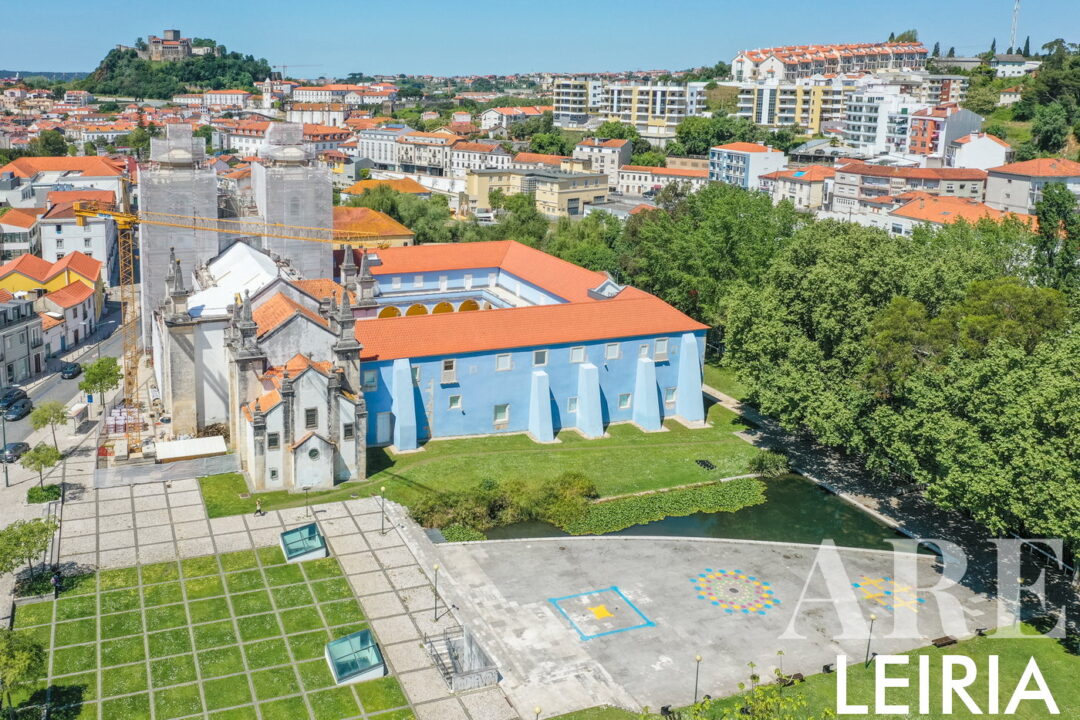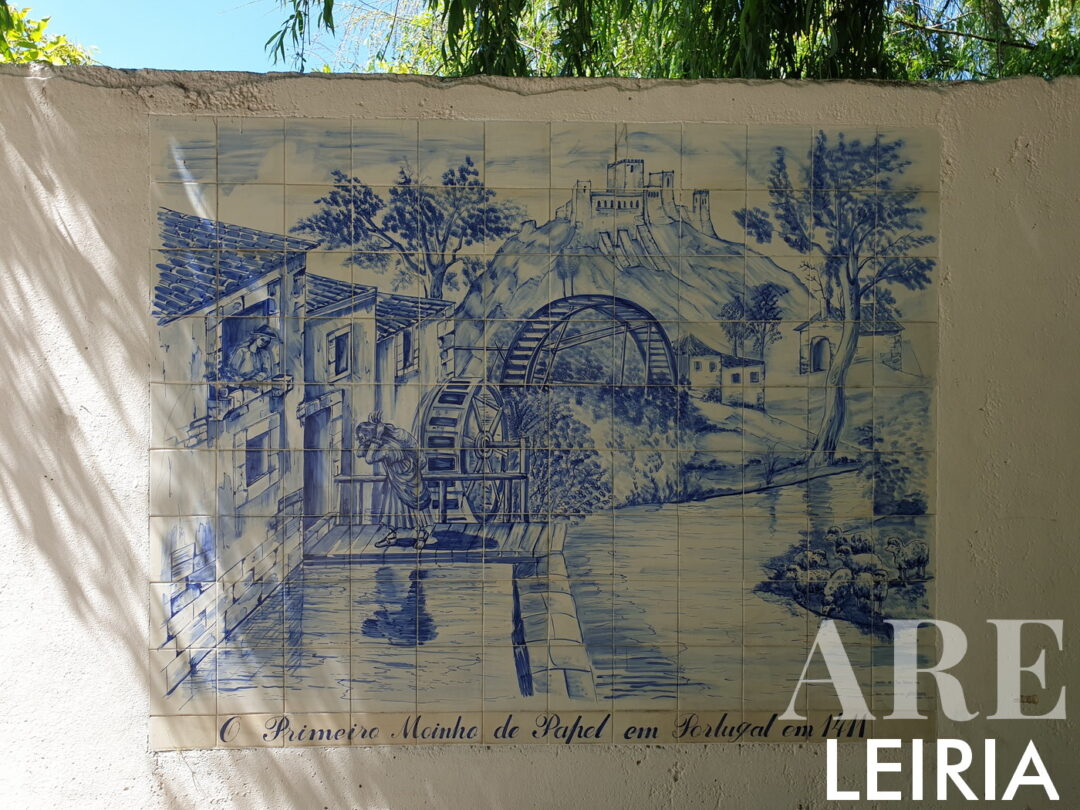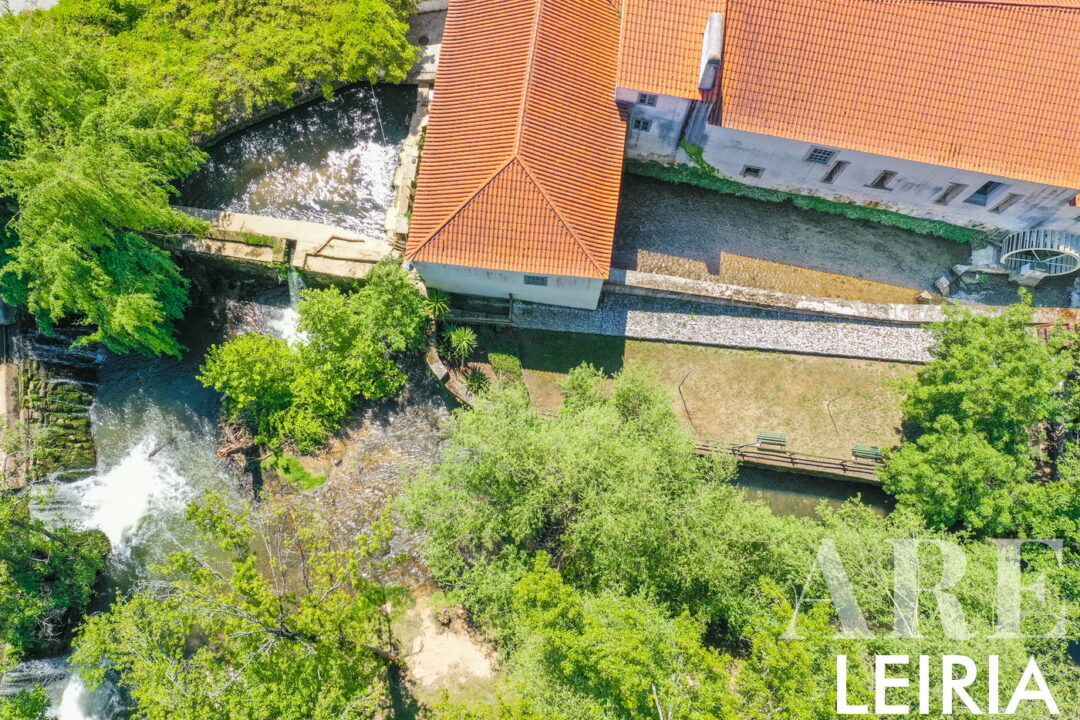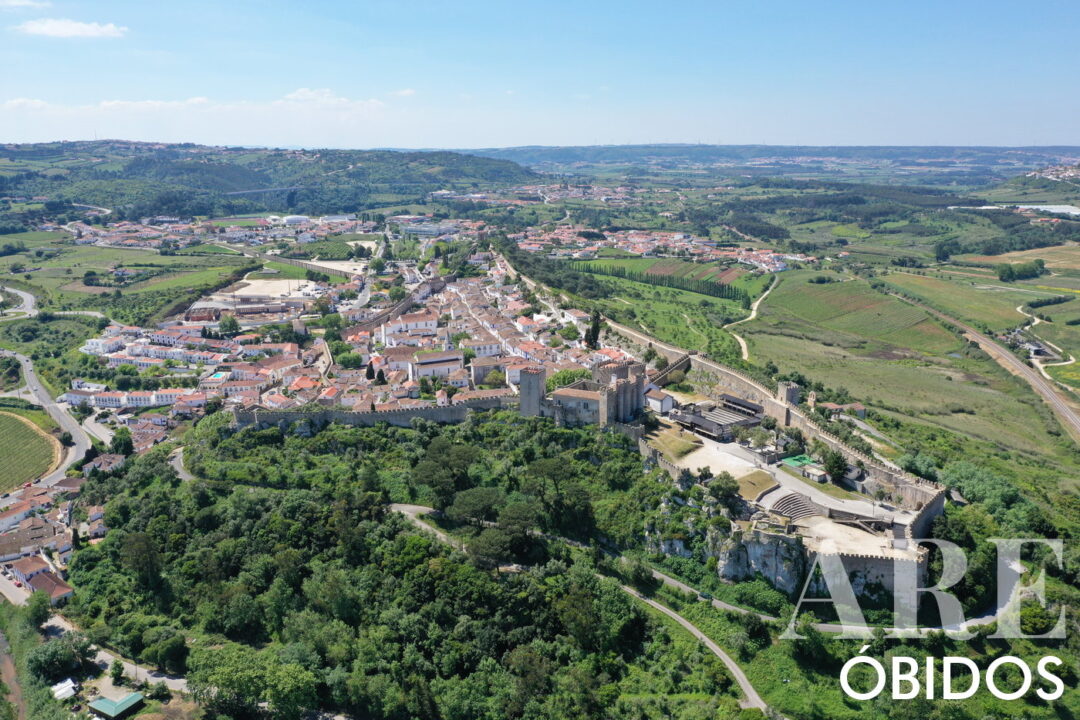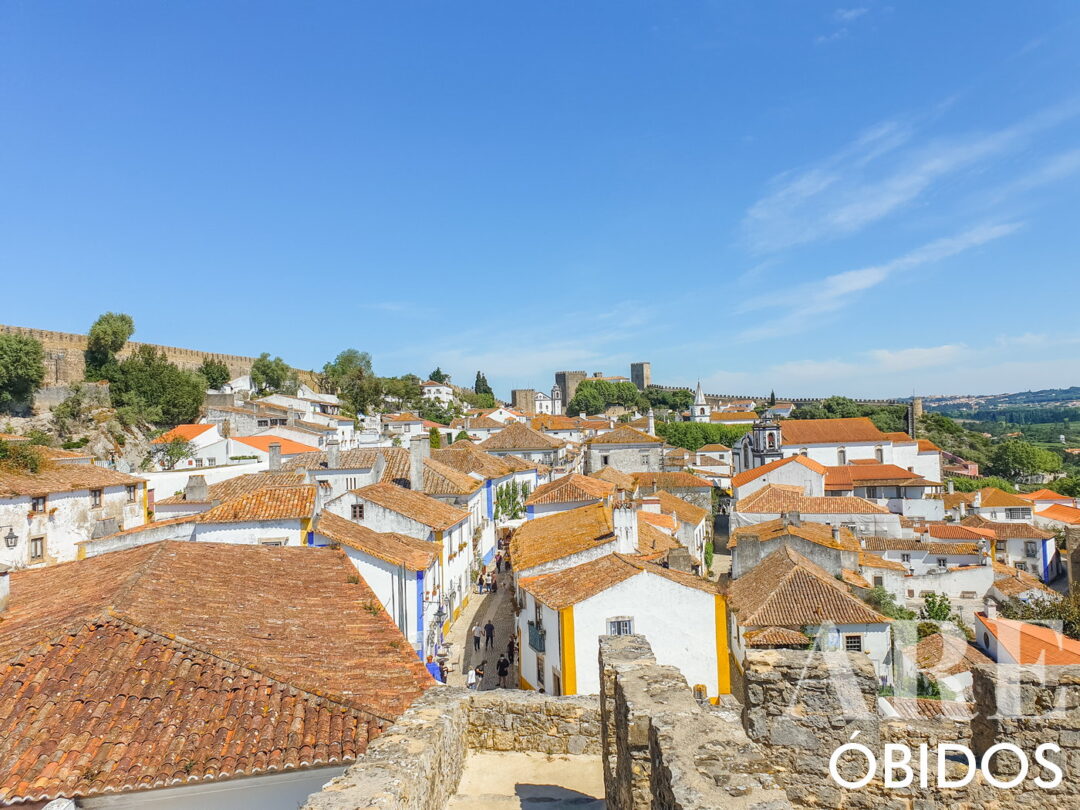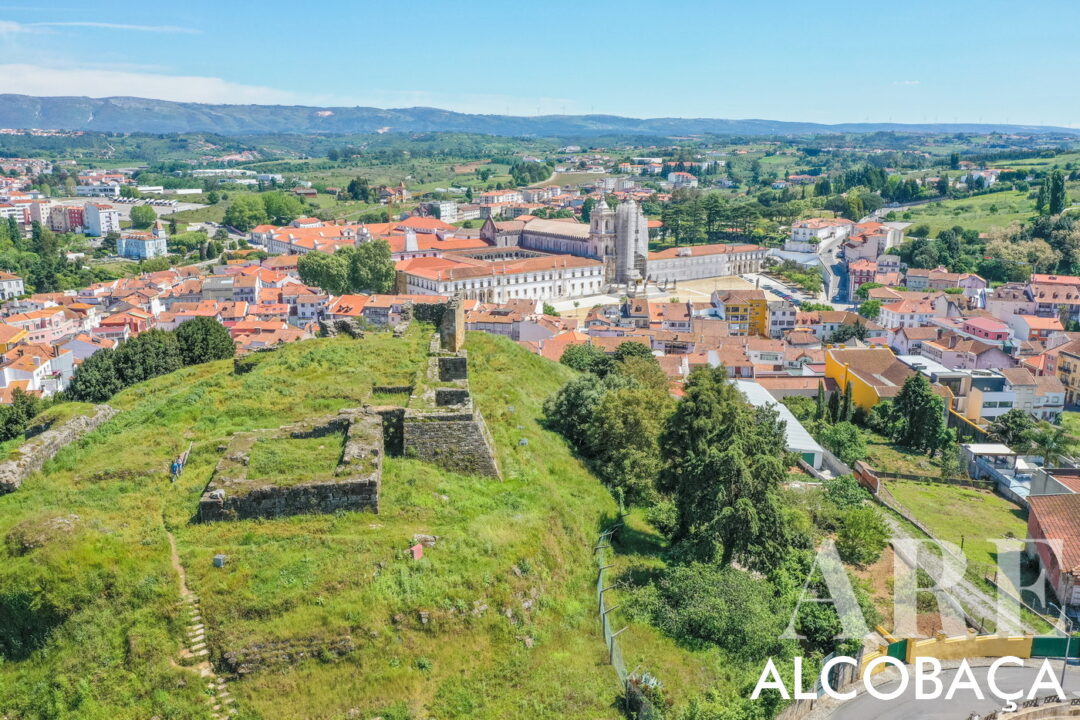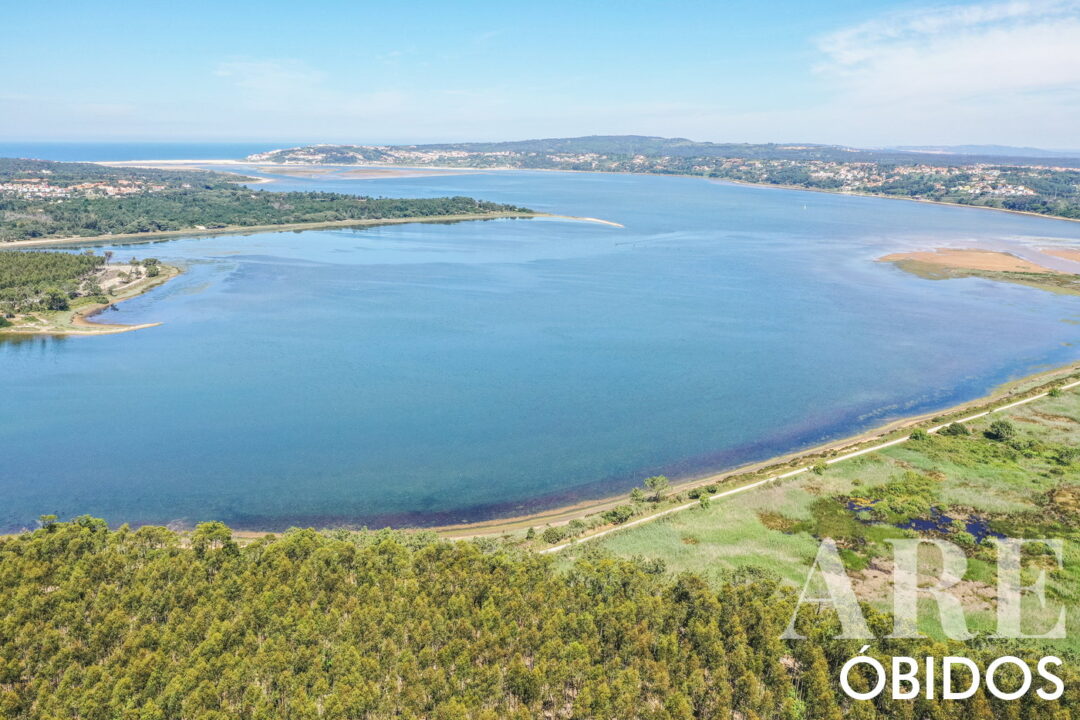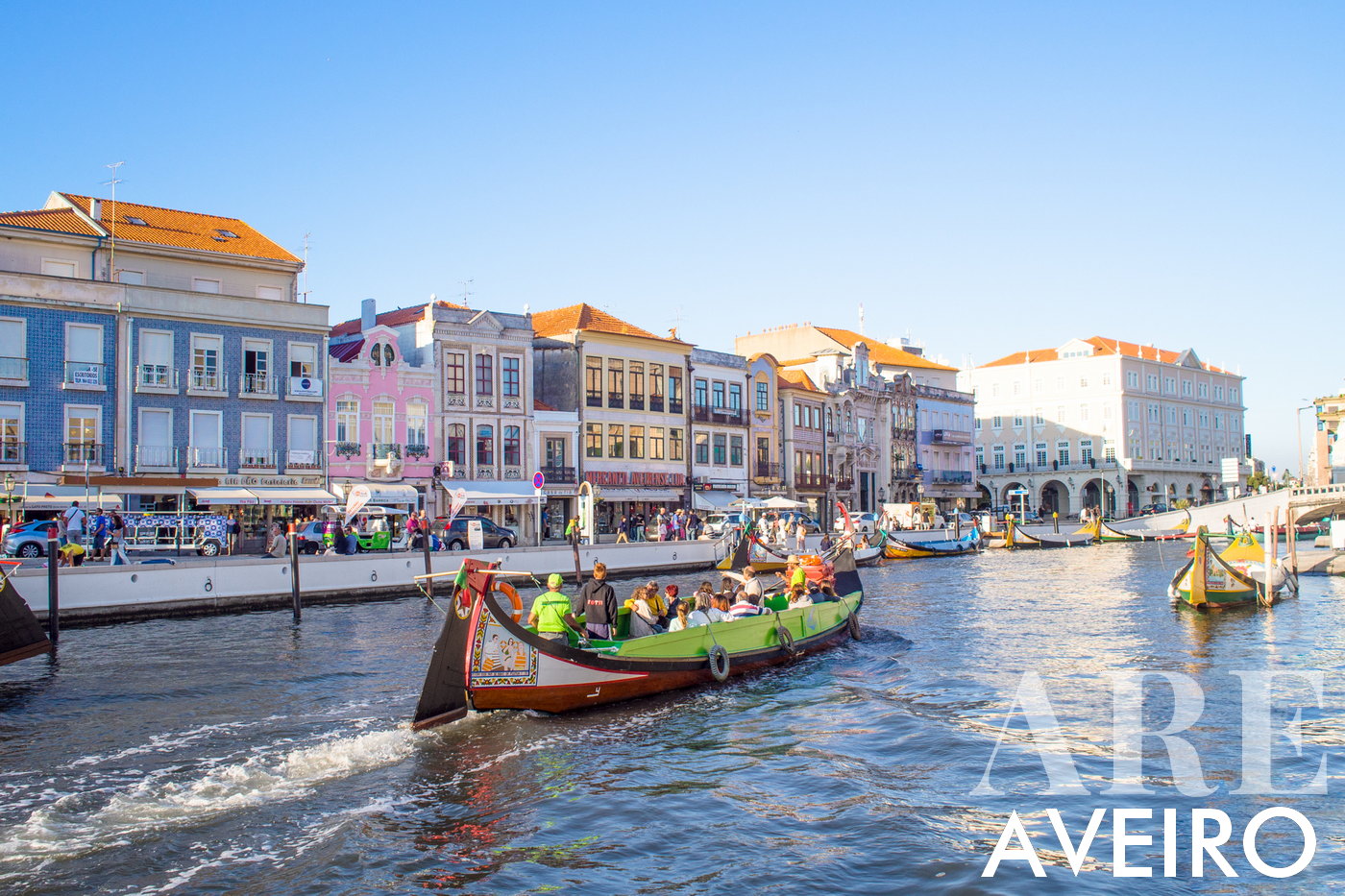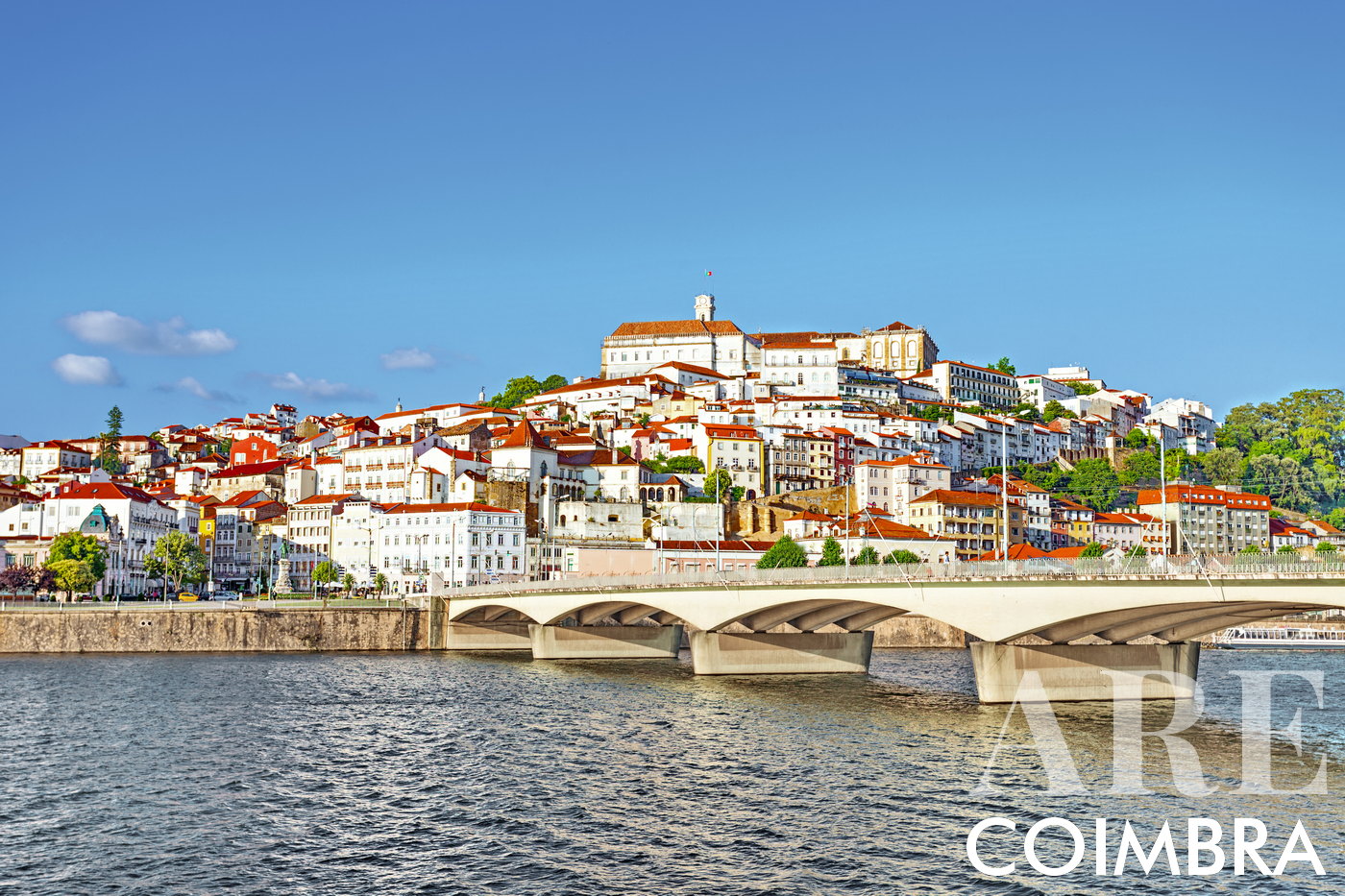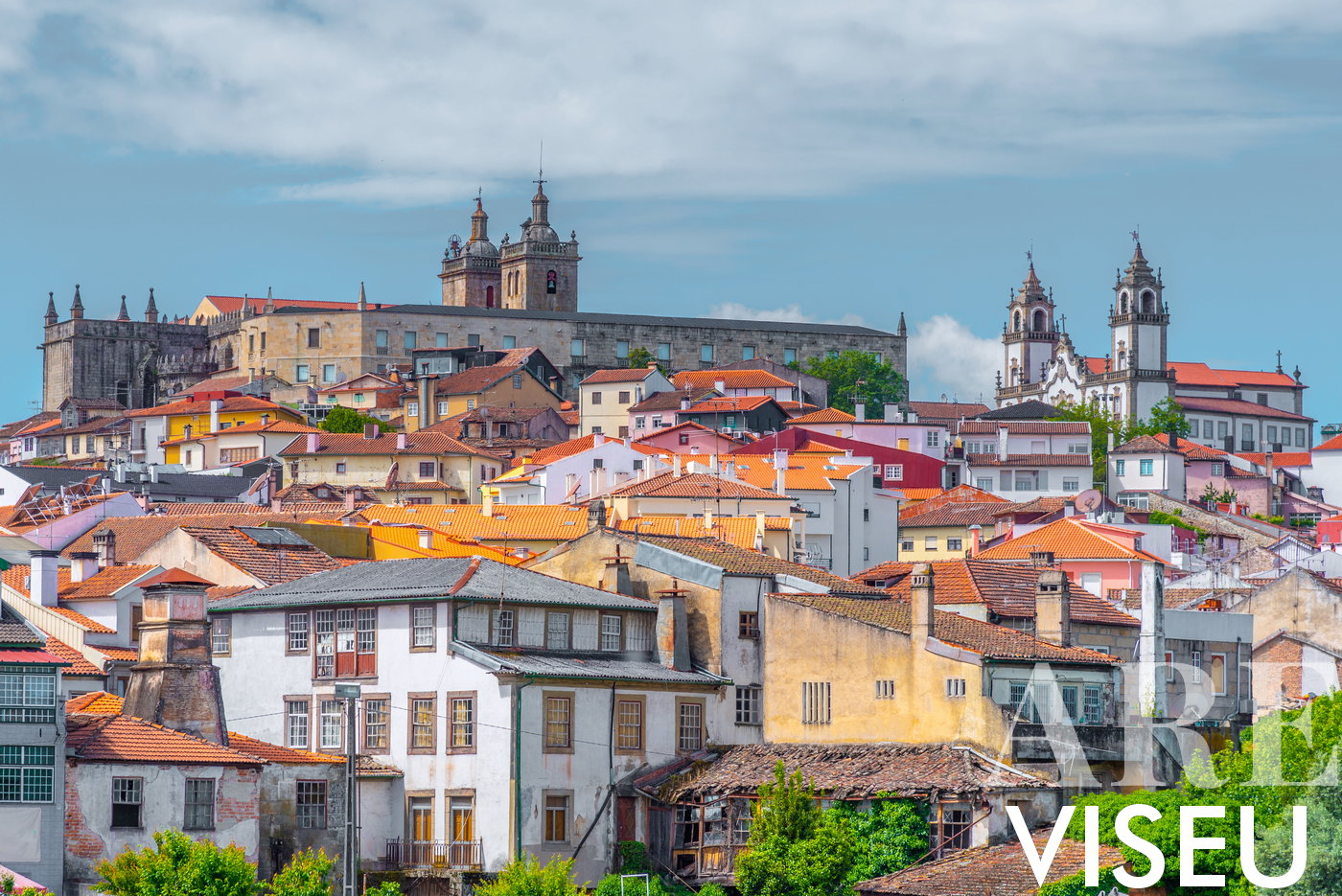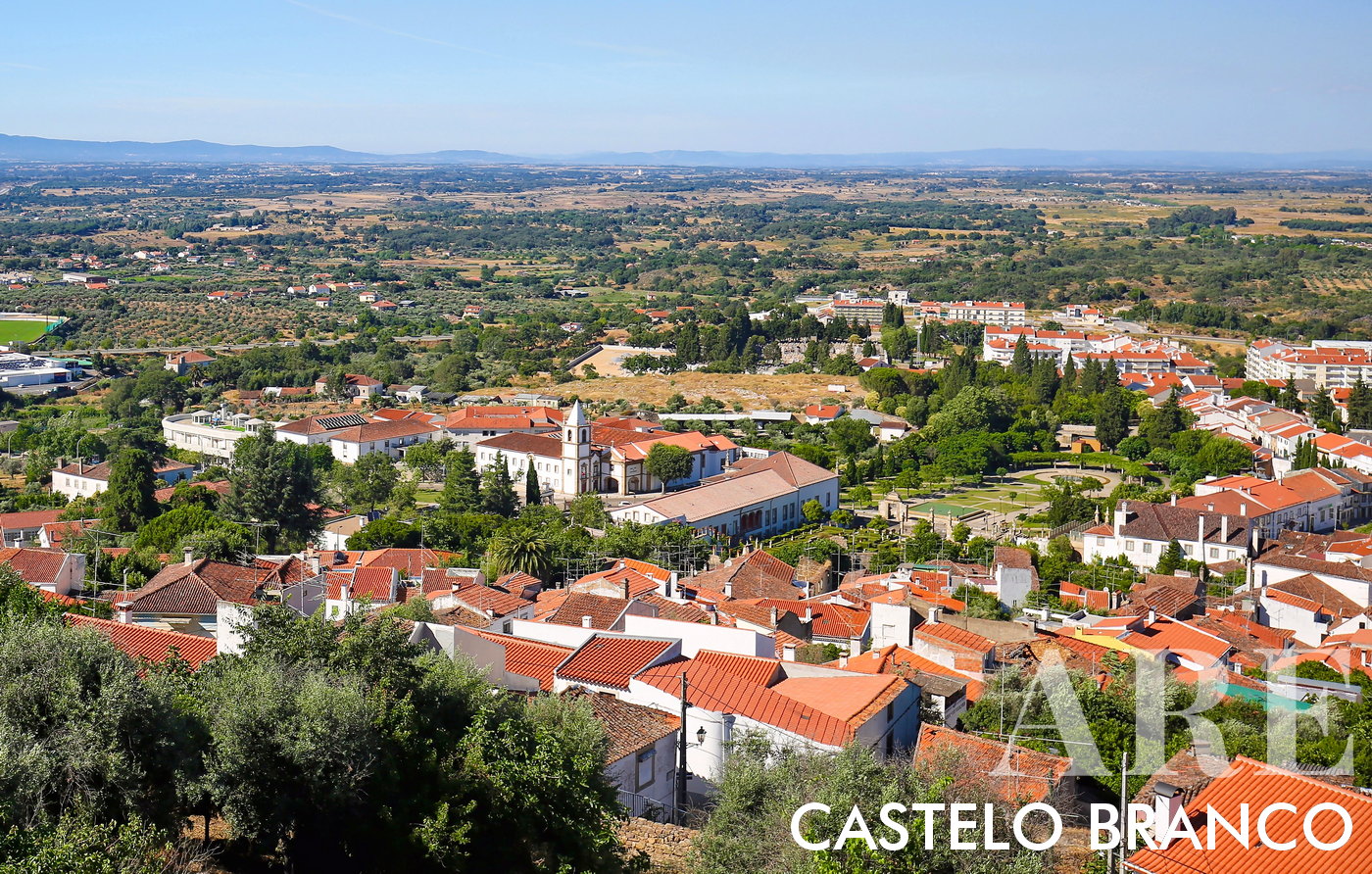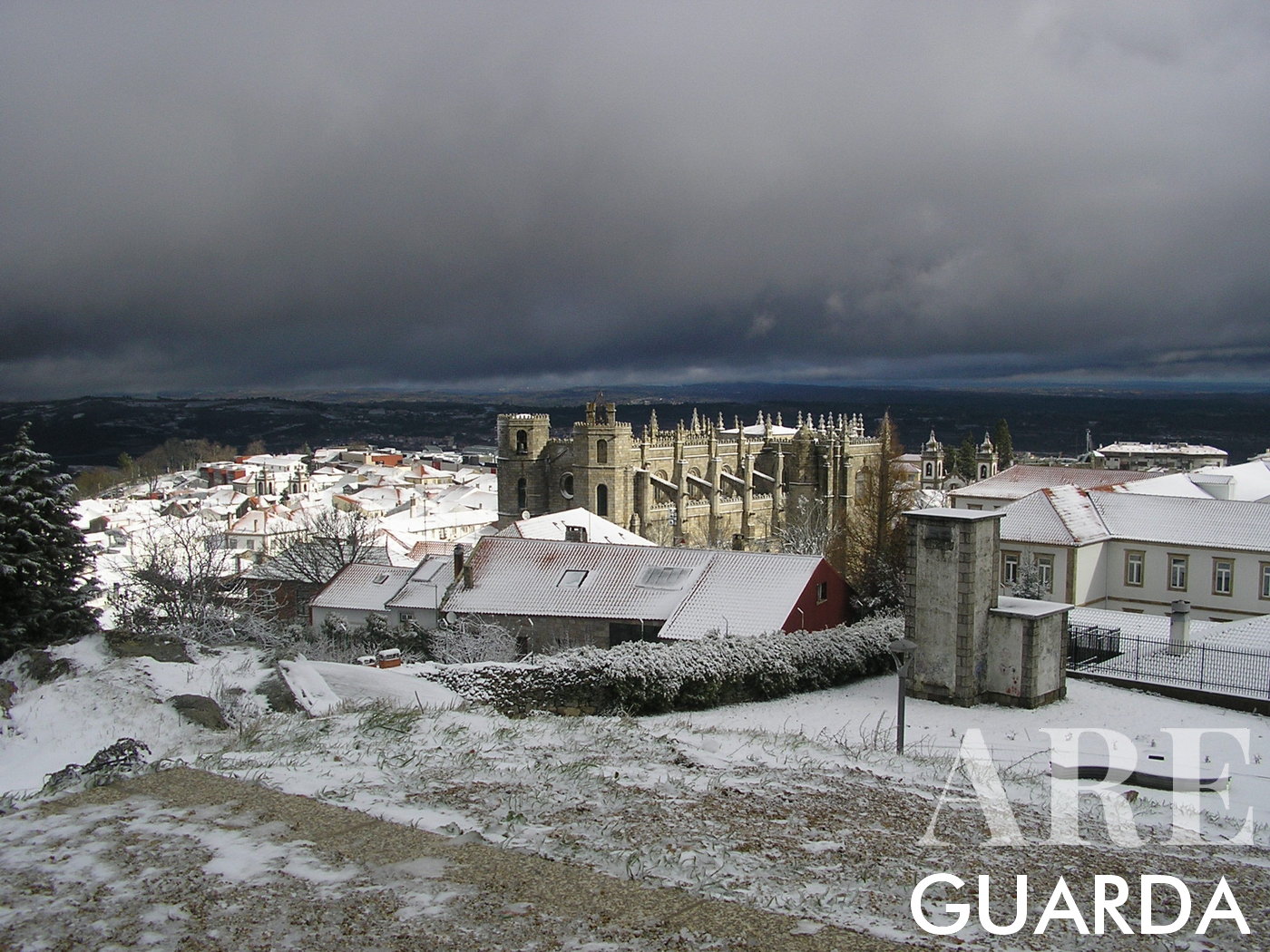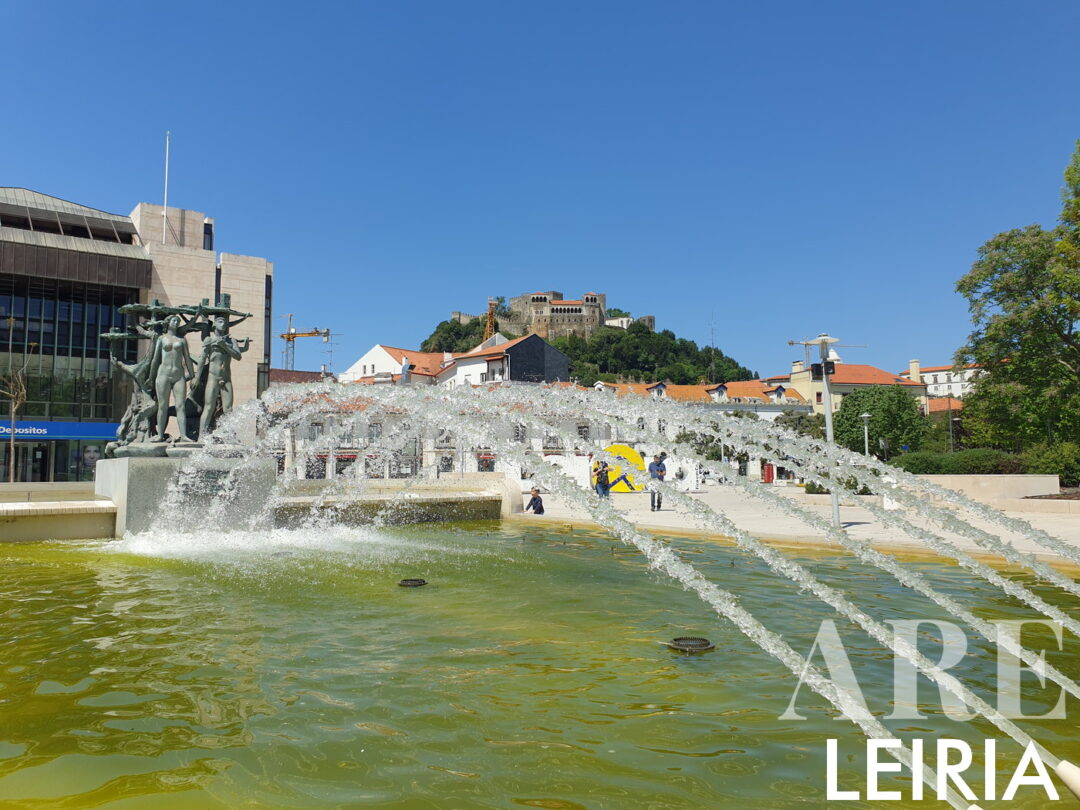
Praça Damião Goa Damão e Diu, with the light source in the center of the city of Leiria, the bronze sculpture, alluding to the Lena and Lis Rivers, Lena being a tributary of the Lis that is born in Serra Daire and empties “in the city of Leiria” , while Lis is born near Leiria, in the place of Fontes, in the parish of Cortes, it crosses the city and will flow into the Atlantic north of Praia da Viera de Leiria.
Leiria is a city known for its rivers, the beach, the pine forest of Leiria, the lagoons, the salt pans, the rock shelters, the religious architecture, the medieval buildings, the museums, the spas, the popular traditions, the crafts and the excellent gastronomy. Recognized for the quality of life and business growth, located in the center of Portugal, it is the capital of the district of Leiria, where we find the mountains of Sicó, Aire and Candeeiros, and the rivers Zêzere, the river Nabão and the river Lis. Leiria is at a distance of 146 kms from Lisbon, and 72 kms from Coimbra. It has a coastline of more than 100km, central part of the Portuguese Silver Coast. It is in the region of Leiria, in Nazaré that we find the biggest wave in the world, it is in Alcobaça that produce the best apples, in Peniche that we surf the best waves in the country, the site of a stage of the world championship, and in Batalha we visit the Monastery da Batalha, one of the most visited attractions in Portugal. An hour and a half away from the cities of Lisbon and Porto, Leiria is in the center of Portugal, with an excellent transport network, with two railway lines and four highways.
Quick facts about Leiria
The district of Leiria is divided into 16 counties:
1. Alcobaça;
2. Alvaiázere;
3. Ansião;
4. Battle;
5. Bombarral;
6. Caldas da Rainha;
7. Castanheira de Pera;
8. Figueiró dos Vinhos;
9. Leiria: the municipality of Leiria has approximately 130 thousand inhabitants, it is administratively organized in 18 parishes: Amor, Arrabal, Bajouca, Bidoeira de Cima, Caranguejeira, Coimbrão, Hives and Memory, Leiria, Pousos, Barreira e Cortes, Maceira, Marrazes and Barosa, Miracles, Monte Real and Carvide, Monte Redondo and Carreira, Partners and Azoia, Regueira de Pontes, Santa Catarina da Serra and Chainça, Santa Eufémia and Boa Vista, Souto da Carpalhosa and Ortigosa;
10. Marinha Grande;
11. Nazaré;
12. Obidos;
13. Pedrógão Grande;
14. Peniche;
15. Pombal;
16. Porto de Mós.
- City population: approximately 60 thousand inhabitants
- Population of the County: approximately 127 thousand inhabitants
- Area: 565.09 kms2
- District: Leiria
- Former Province: Beira Litoral
- Santa Padroeira: Nossa Senhora da Conceição
- Municipal Holiday: May 22
- Exports: represent 4% of the national total
The city of Leiria
The city of Leira can be divided into two main areas:
1. Historic Center: it is the oldest part of the city. Here we can visit Praça Rodrigues Lobo, a meeting point for the inhabitants of Leiria and where we find the stores of the main world brands installed in historic buildings. The maximum exponent is the Garage building, an example of new art from the early 20th century. In this historic center we find Praça Cónego Maia, with the Episcopal Palace building that houses the Spanish brand Zara; the Ateneu de Leiria built at the end of the 19th century and the Zúquets building, built at the end of the 19th century, where there are some restaurants, shops and cafés in the city. Also in the Historic Center is Praça de Sant’Ana, the busiest area of the city, where the Mercado de Sant’Ana is, a busy cultural center throughout the year.
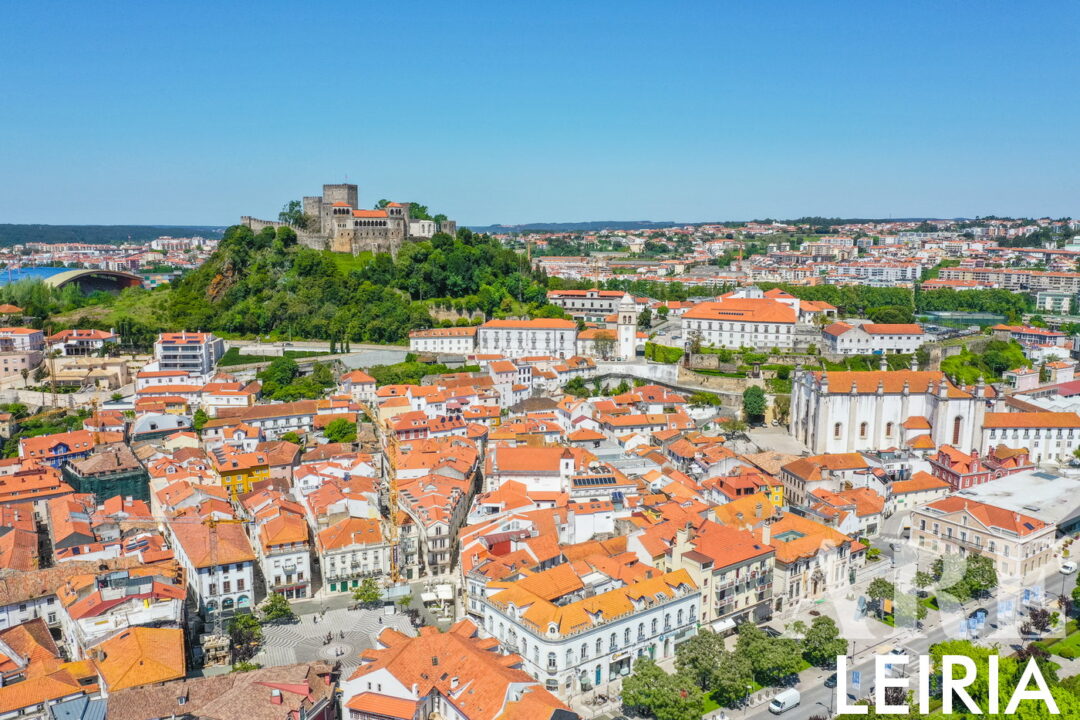
Historic center of the city of Leiria, with Rodrigues Lobo square, the historic buildings around, the cathedral of Leiria on the right, the municipal stadium of Leiria on the bottom on the left, and the castle at the top of the image
2. Lis River area: it is the ideal place for cycling and walking. On the right bank of the River Lis we find two museums: the Museu de Leiria and the Museu do Moinho de Papel, two heritage references of the city. On the left bank of the River Lis we find the Municipal Museum of Leiria and the Convent of Santo Agostinho.
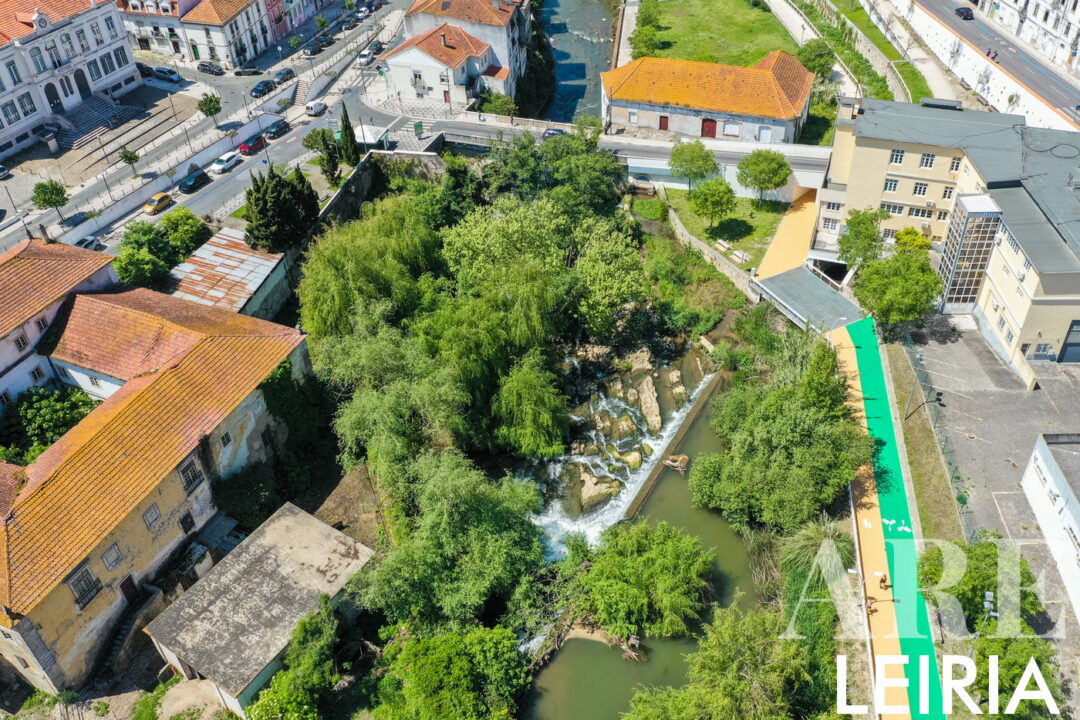
Lis River area in Leiria, with the river passing through vegetation, natural stone waterfalls, and spaces for sport and walking. The atmosphere in this place is fantastic, with the sound of the river water, and the surrounding trees.
Attractions to visit in Leiria (TOP 10)
Luís de Camões Garden
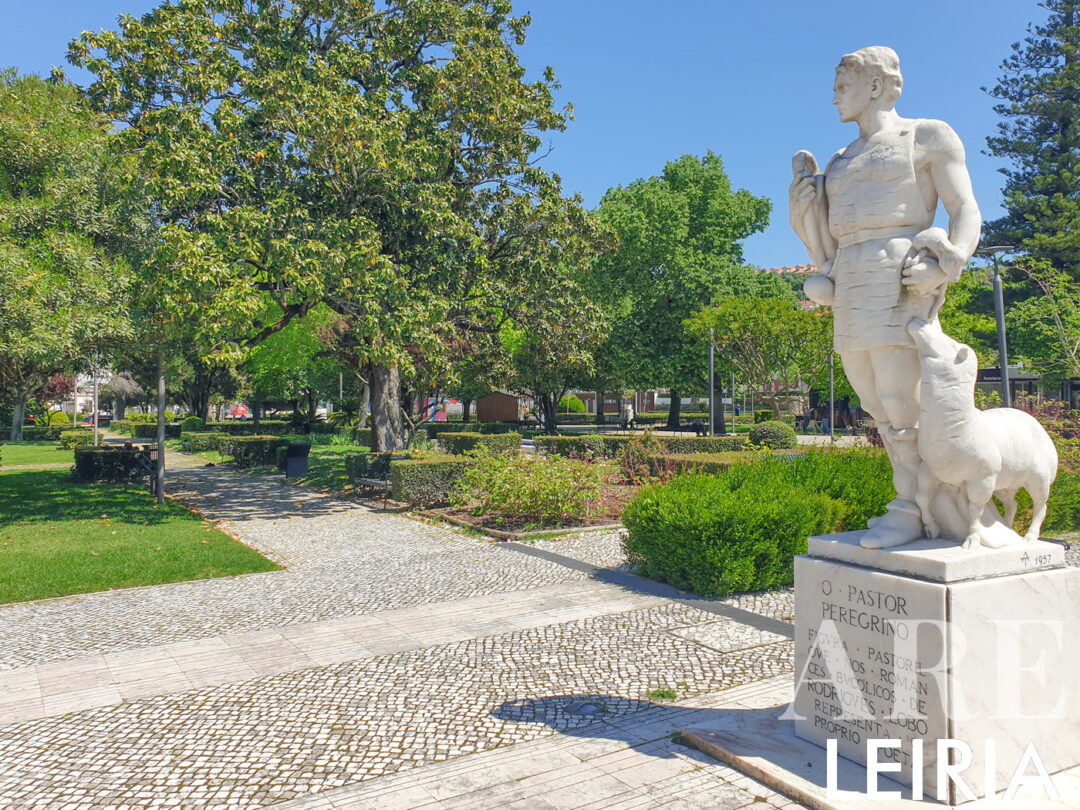
Jardim Luís de Camões by the river Lis in Leiria, with the statue of the Shepherd Pilgrim with the sheep.
Luís de Camões Garden: it is a park with garden areas in the center of the city, where we find the main church of the city, and from where we can admire the magnificence of Castelo de Leiria at the top of the hill, and the presence of the o Lis river, a river that played and plays a fundamental role in the growth of the city.
Castelo de Leiria
Castelo de Leiria: it is an imposing castle, built at the highest point of the city with the objective of defending the population from attacks by Muslims. The construction of the Castle of Leiria was ordered when the city was conquered by Dom Afonso Henriques in 1135. The castle was attacked several times during the 12th century, namely in 1137, 1140 and 1144. The most aggressive attack was in 1140, with death of 20 knights and the prison of Dom Paio Guterres (first Alcaide de Leiria). Castelo de Leiria was home to many kings and queens, namely Dom Afonso III, Dom Dinis, Dom Afonso IV, Dom Pedro I, Dom Fernando. The castle started to decay from the 18th century when the population started to steal stones to build their houses. This situation lasted until the 20th century, when architects Ernest Korrodi and Tito de Sousa Larcher rebuilt some parts of the Castle. The main highlights of the castle are: the doors of Albacara; the Guarda house; the Buraqueira door; the church of Santa Isabel da Pena; the ruins of the Collegiate; the Paços Novos; the Keep; the door of Betrayal; and cisterns;
Cathedral of Our Lady of the Immaculate Conception, Leiria
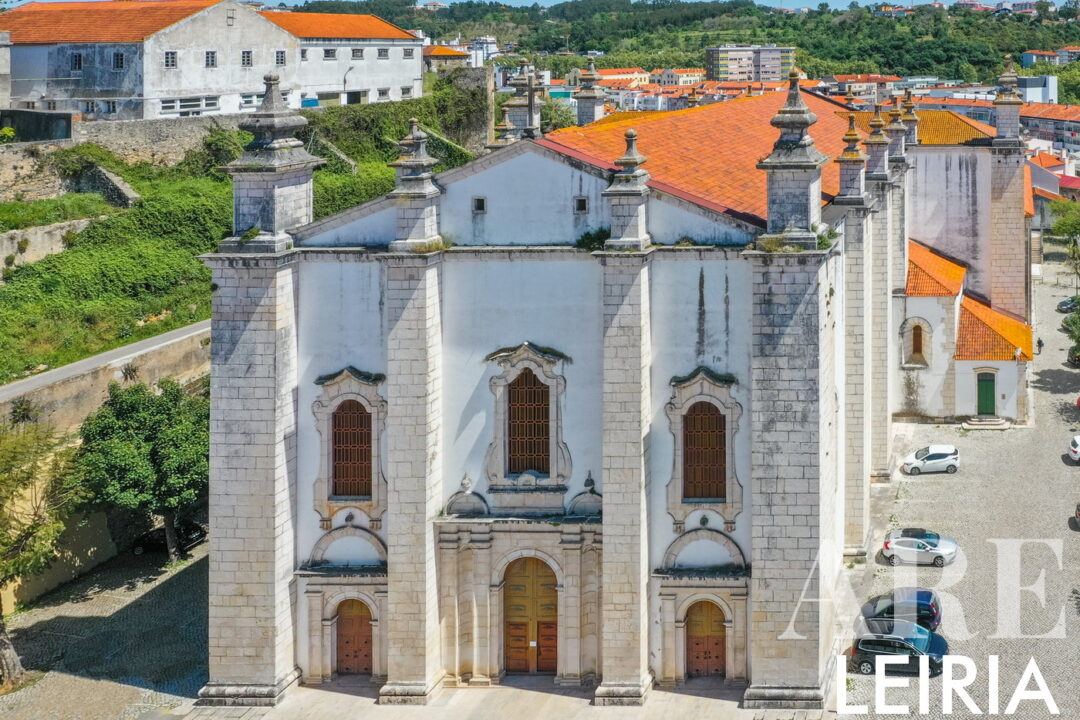
Cathedral of Leiria, Our Lady of the Immaculate Conception, of Joanine architecture built in the 16th century
Cathedral of Our Lady of the Immaculate Conception, Leiria: it was built in the 16th century, it presents the same model as two other cathedrals in the country, namely the Cathedral of Portugal and the Cathedral of Miranda do Douro, considered Joanine Cathedrals, built during the Reign of Dom João III. The Sé de Leiria was built in a Mannerist style, and is currently one of the best examples of hall churches, along with the Monastery of Alcobaça and the Monastery of Jerónimos. The Sé de Leiria was partially destroyed during the 1755 earthquake, and during the French Invasions of 1808-1814. The main highlights are an altarpiece with a painting by Simão Rodrigues with episodes from the life of Virgin Mary, the two organs in Baroque style, the Bell Tower of 1772 with the coat of arms of the Bishop of Leiria Dom Miguel de Bulhões e Sousa, and the side chapels dedicated to the Blessed Sacrament and Our Lady of Sorrows;
Museu de Leiria
Museu de Leiria: it is a museum installed in the Convento de Santo Agostinho, with the history of the city and the region of Leiria since Prehistory, and thematic exhibitions. The museum was opened on November 15, 2015 with the aim of promoting the history and identity of the city of Leiria;
Moinho de Papel
Moinho de Papel: it is the first windmill in Portugal, built in 1411. The mill was renovated by the architect Álvaro Siza Vieira with the aim of disseminating and preserving the old methods of milling cereals, making paper and olive oil. The mill museum includes pedagogical workshops, rooms for exhibitions, and rooms for conferences and meetings;
Glass Museum
Glass Museum: it is a permanent exhibition with collections of the activity of Portuguese glass, from the 17th century to the present, the only museum dedicated to the study of art, crafts and the glass industry in Portugal
Museum of Image and Movement – MIMO
Museum of Image and Movement – MIMO: the museum was created in 1996, the year of the centenary of cinema in Portugal, with the objective of disseminating and preserving all kinds of existing content related to photography and cinema. In this museum it is possible to observe the historical evolution of cinematography throughout the time;
Sanctuary of Nossa Senhora da Encarnação
Sanctuary of Nossa Senhora da Encarnação: it is a chapel classified by IPPAR in 1982 as a Building of Public Interest, built in 1588 in Neoclassical Style, with emphasis on the arches of the main facade, the staircase of 162 steps, and the tiles 17th century originals with themes dedicated to Saint Gabriel and the Virgin;
Sanctuary of Nossa Senhora dos Milagres
Sanctuary of Nossa Senhora dos Milagres: it is a church built in 1750 after an alleged miracle of the Lord Jesus. It is an imposing Baroque church, with two bell towers, a chancel, and tile panels from 1795 by Silva e Sousa;
José Lúcio da Silva Theater
José Lúcio da Silva Theater: it is a theater open to the public with a capacity for 763 seats, where we can watch presentations of music, dance, and cinema. The theater was inaugurated on January 15, 1966, with the presence of the President of the Republic Admiral Américo Thomaz.
Attractions to visit in the region of Leiria
Buddha Eden
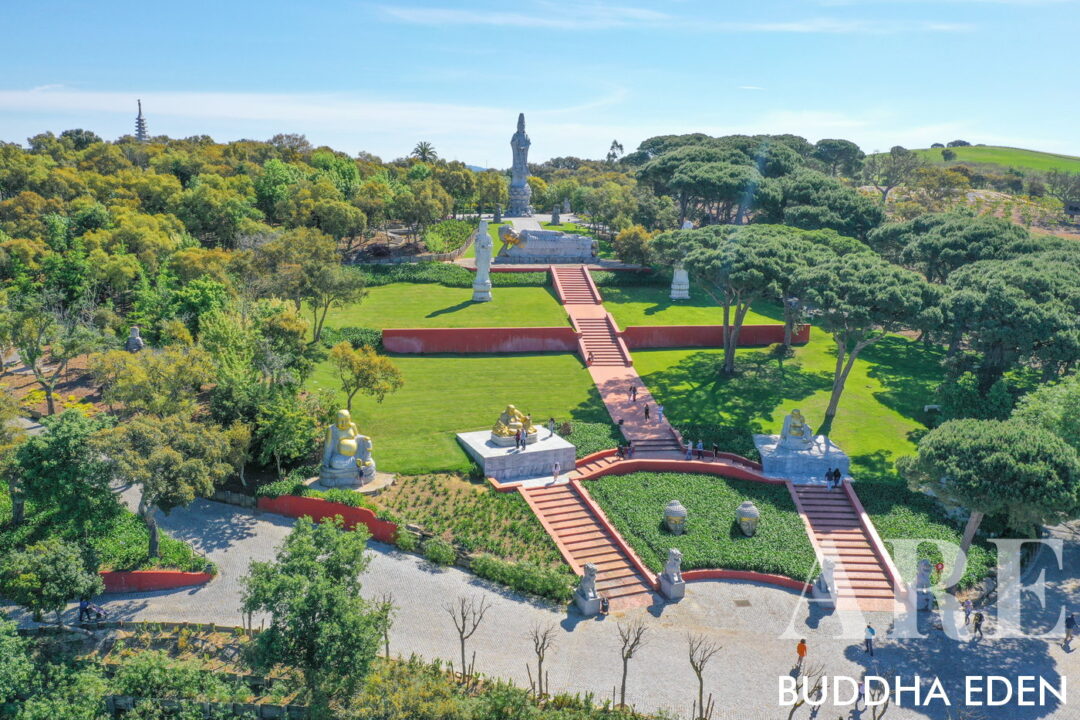
Buddha Eden, at Quinta do Loridos, an outdoor art garden, with Asian sculptures, figures of giant Buddhas, and ponds.
Buddha Eden: it is a garden inserted in a theme park in Quinta dos Loridos with 35 hectares, where we find the largest oriental garden in Europe, decorated with about 600 hand-painted terracotta soldiers, large buddha statues, pagodas, several sculptures decorated among the vegetation, a central lake with KOI fish, sculpted dragons. At Buda Eden we find themed spaces with a selection of modern art by various artists from the Berardo collection, and a space with African sculpture art dedicated to the Shona people of Zimbabwe. Bacalhoa Buda Eden has wine tasting in the old cellar in the garden of the manor or in the Bacalhôa wine shop. Buda Eden is known as Jardim da paz, Jardim dos Budas, Jardim do Eden, Jardim Buddha Eden, Jardim do Bombarral. It is the most visited and most loved attraction in the Leiria region, with free admission for children up to 12 years old;
Óbidos Castle
Óbidos Castle: it is a historic castle from the 12th century, where we find the neighborhood of the village of Óbidos within the walls, with a 1565 meter round road, located in Óbidos 79 meters above the sea level, declared a National Monument in 1910. The Castle is located in the castelejo area, where we find the current guesthouse of the Castelo de Óbidos, and the Óbidos district inside the wall, a neighborhood with colorful houses, narrow and labyrinthine streets, flower beds in the entrances, low houses, tiles in the windows, and small local shops, where we can taste the famous alcoholic liquor “Ginjinha de Óbidos”. Access to the interior of the walls is made through four doors and two shutters, with emphasis on the main entrance at Porta da Vila or Porta de Nossa Senhora da Piedade, an entrance with the roofs decorated with tile 18th century, with exit to Rua Direita, the main street of the village of Óbidos. The Castle of Óbidos was declared in 2007 “the second of the seven most relevant monuments of the Portuguese architectural heritage” by the contest the Seven Wonders of Portugal, and UNESCO in 2015 considered Óbidos as a literary city;
Batalha Monastery

Batalha Monastery, national pantheon, UNESCO world heritage site, with the equestrian statue of Constable D. Nuno Álvares Pereira, considered one of the best warriors in Portugal
Batalha Monastery: or Santa Maria da Vitória Monastery is a Manueline-style Dominican monastery, classified as a National Monument since 1910, a UNESCO World Heritage Site, elected in 2007 as one of the Seven Wonders of Portugal, and the status of National Pantheon since 2016. The monastery was built over two centuries until the 16th century, during the reign of seven kings of Portugal, having been started by King D. João I in the 14th century as a thank you to the Virgin Mary for victory against the Castilian rivals in the battle of Aljubarrota. Currently the Batalha Monastery is a National Museum and Pantheon;
Monastery of Alcobaça
Monastery of Alcobaça: or Real Monastery of Santa Maria de Alcobaça is a 12th century monastery in Gothic, Manueline, Mannerism and Baroque style, classified as World Heritage by UNESCO, as a National Monument since 1910, and elected as one of the Seven Wonders of Portugal in 2007, the ex-libris of the town of Alcobaça, and one of the most important monuments of the Cistercian Order in all of Europe.
Suberco viewpoint
Suberco viewpoint: is a viewpoint located near Sitio da Nazaré, in the Fort of São Miguel Arcanjo a fort built in the 17th century mannerist style, also known as Fort of Morro da Nazaré where there is a small museum with information on historical themes and on the geological nature of the Nazaré canyon, research and development. From the viewpoint we can see the village and the beach of Nazaré, the Lighthouse of Nazaré, the giant waves and the sand as far as the North beach in Nazaré is concerned. It is a place with fantastic energy that we can only feel when we visit;
Praia da Nazaré
Praia da Nazaré: it is the sandy beach that we find in front of the village of Nazaré. During the bathing season, Nazaré beach gains a typical feature full of color due to the traditional tents that are set up on the beach to rent to vacationers;
Farol da Nazaré
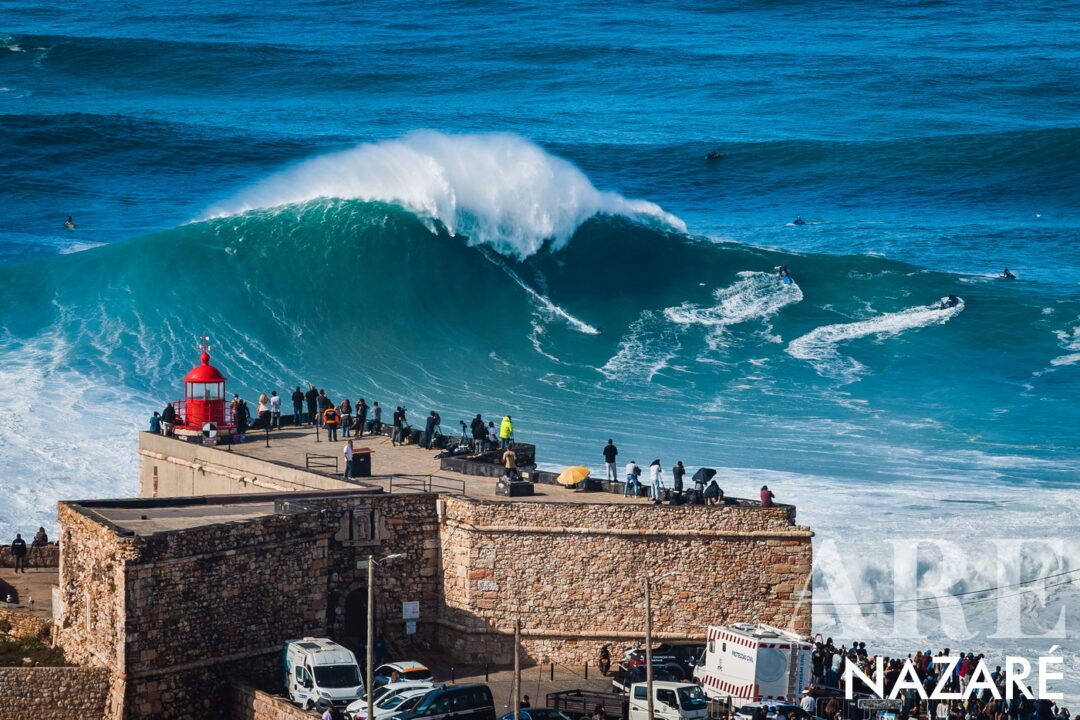
Nazaré Promontory, with the São Miguel Arcanjo Forte De Farol da Nazaré, and Praia do Norte, known for giant wave surfing
Farol da Nazaré: it is one of the lighthouses of Portugal classified as a Property of Public Interest, located in the Fort of São Miguel Arcanjo, much admired for being located in front of the Sitio da Nazaré, close to the Suberco viewpoint, and the Praia do Norte da Nazaré where giant waves surf;
Serras de Aire e Candeeiros Natural Park
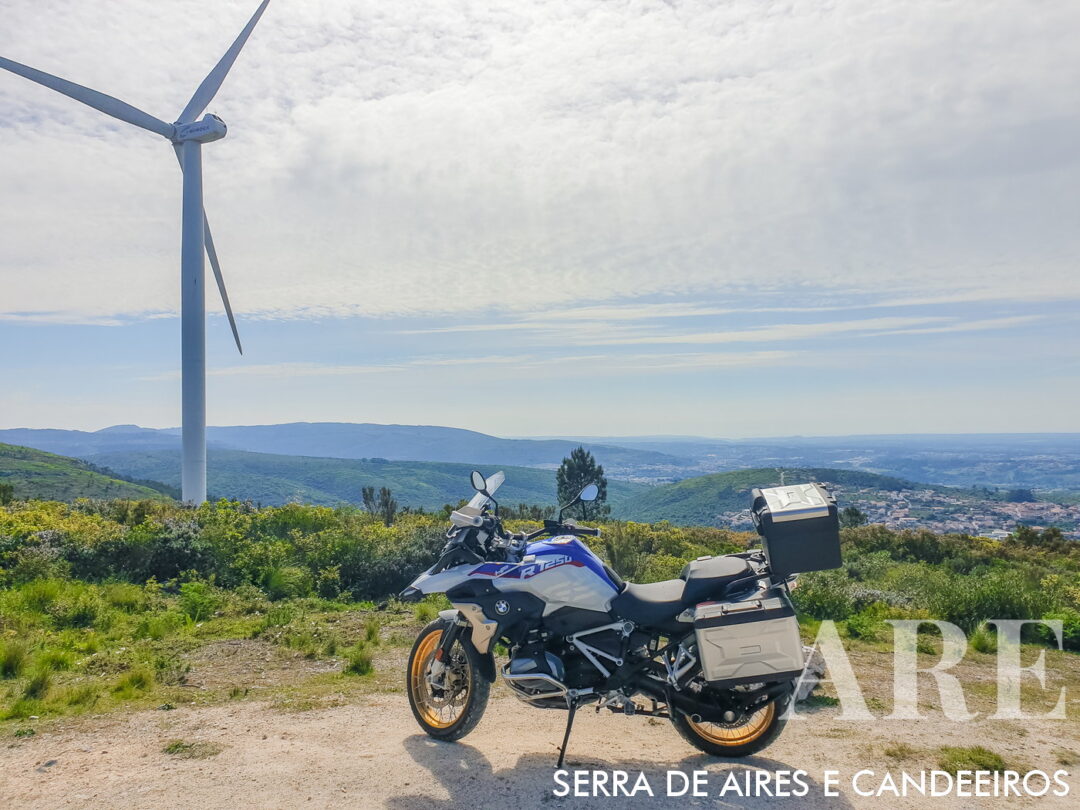
Jurassic viewpoint, in Serra de Aires and Candeeiros, with a panoramic view of more than 27 km in a straight line to the sea
Serras de Aire e Candeeiros Natural Park: it is a natural park with a limestone landscape and the largest underground freshwater reservoir in Portugal, fed by rainwater in the form of underground streams, extending from Rio Maior to Porto de Mós, where we find more than fifteen hundred caves, algares (vertical caves dug in the limestone rock naturally due to water erosion), fields of lapiás (karst reliefs, a type of geological relief characterized by the dissolution of the rock), dolines ( some with lagoons), uvalas and Polje. In other words, rocks worked by erosion, creating caves, caves, lakes and other places of great spectacularity. In the Serras de Aire e Candeeiros Natural Park we find the caves or caves of Mira de Aire a well-known geological attraction in Portugal, and the source of Olhos de Água do Alviela, responsible for supplying water to Lisbon since 1880. The Serras de Aire e Candeeiros Natural Park is also a place for bird watching, bats, rare mammals, reptiles, amphibians, insects, with more than 300 species of butterflies and other species. Here we also find the Natural Monument of the Dinosaur Footprints of Serra de Aire, an area of approximately 20 hectares classified as a Natural Monument discovered in 1994, with traces of sauropods (one of the two large groups of dinosaurs with large bodies, with a long neck that ended in a small head, and a very long tail) 20 of the largest, oldest and clearest known trails, with an age of 175 million years;
Parque Dom Carlos I
Parque Dom Carlos I: it is a very visited romantic garden, with a very pleasant natural environment, created by kings, queens and nobles, in a wooded space located in Caldas da Rainha, which was formerly a place of vineyards and of olive trees, later a park of a thermal hospital where patients could walk and recover. Currently we find a large landscaped and wooded park with secular trees, with a lake with boats, fountains decorated with tiles, restaurant-bar with terrace, picnic area, tennis court, and the José Malhoa Art Museum with collections painting, sculpture, medals, drawing and ceramics from the 19th and 20th centuries, with a collection composed of works by 251 artists;
Berlengas Nature Reserve
Berlengas Nature Reserve: it is a classified archipelago UNESCO World Biosphere Reserve since 2011, composed of the island Berlenga Grande, 1.5 km long and 0.8 wide, where we can visit the Duque de Bragança Lighthouse built in 1841 with 29m high, with visible light up to 50 km away on days of atmospheric transparency., the São João Baptista das Berlengas Fort, the Carreiro do Mosteiro Beach, restaurants and the campsite; Island stars; and Farilhões island; located in front of the city of Peniche 5.7 miles west of Cape Carvoeiro. It was the first protected area in Portugal in 1465, when King Afonso V of Portugal prohibited hunting on the main island. Currently the Berlengas archipelago is considered one of the best places in Portugal for diving and observation of marine life, and a reference point for the observation of sea birds;
Paredes da Vitória Beach
Paredes da Vitória Beach: it is a beach with more than 2 kilometers of idyllic natural landscape, located in front of the small village of Paredes de Vitória on the north coast of the municipality of Alcobaça, with an extensive sand in front of a limestone cliff lined with vegetation, bathed by the Atlantic Ocean with good regular conditions for surfing and other nautical activities. Paredes da Vitória beach is located 11 kilometers in a straight line north of the North beach in Nazaré;
Praça-forte de Peniche
Praça-forte de Peniche: it is a citadel full of history, with great importance for the defense of Portugal since the middle ages. The Fort is located on the southern slope of the Peniche peninsula where we can visit the Museu da Resistência e da Liberdade known as Museu da Cidade, with exhibitions related to underwater and terrestrial archeology in the Peniche region, an important Roman pottery, themes related to bobbin lace (handicrafts from the region), arts related to fishing and shipbuilding, with objects originating from the shipwreck of the San Pedro de Alcântara galleon in Papôa de Peniche, and others themes;
Moeda Caves
Moeda Caves: limestone caves with a visitable extension of 350 meters, reaching a depth of 45 meters, located in the vicinity of Cova da Iria, in the city of Fátima, with a wide diversity of clay and calcite materials;
Cabo Carvoeiro Lighthouse
Cabo Carvoeiro Lighthouse: it is a quadrangular lighthouse open to the public every Wednesday from 2 pm to 5 pm, one of the oldest lighthouses on the coast of Portugal, in operation since 1790 located on the Peniche peninsula, at an altitude of 57 meters above sea level, with a height of 27 meters and a range of 15 nautical miles on days of atmospheric transparency;
Praia do Pedrogão
Praia do Pedrogão: is a traditional fishing beach located in the parish of Coimbrão, with an extensive sand flanked by dunes vegetated by sea thistle, in front of the small settlement of Pedrogão where we find a marginal with restaurants and terraces. The beach is limited to the south by a shale rock formation, however it extends to the north by a wild area of 15 km of beach and dunes with vegetation until the beach of Leirosa, in the municipality of Figueira da Foz;
Fragas de São Simão
Fragas de São Simão: it is the place where we find the village of Casal de São Simão, one of the 27 Schist Villages of Portugal, the route of São Simão, where we pass the wooden walkway of the Fragas de São Simão along the banks of the Ribeira de Alge where we find the river beach of clear water, in a wild and agricultural landscape, by tops and valleys, with vegetation and rock, with connection from Miradouro das Fragas from São Simão to the Village of Casal de São Simão. The village of Casal de São Simão is a traditional village with stone houses built side by side by a single street, and where we can visit the Chapel of São Simão, dated 1458, one of the oldest temples in Figueiró do Vinhos;
Praia da Consolação
Praia da Consolação: it is a beach that attracts thousands of people due to the therapeutic conditions provided by the iodine accumulated in the south bay, which according to the popular is effective in the medical treatment of the spine. The beach is divided in half by the Forte da Praia da Consolação built in 1641 to reinforce the defense of Peniche, classified as a National Monument since 1978, where we can visit the museum dedicated to the geological and military historical heritage of the region of Peniche. To the north of the fortress we find the beach with a sand that extends for another 2 kilometers towards Peniche, passing by the Super Tubo beach, where one of the stages of the world surf championship takes place;
Mariparque – Praia da Vieira
Mariparque – Praia da Vieira: it is a water park located on Vieira beach open during the bathing season, near a hotel area, with slides, slides, tobogans and snail tracks with several outdoor pools, radical activities and permanent entertainment for adults and children;
Porto de Mós Castle
Porto de Mós Castle: or D. Fuas Roupinho Castle is a dominant building over Porto de Mós, classified as a National Monument in 1910, built in the Gothic and Renaissance style, it was a point strategic in the defense of Leiria and Coimbra since the 12th century;
Praia dos Supertubos
Praia dos Supertubos: also known as Praia do Medão is a beach in Peniche known for the tubular shape of the waves, excellent for surfing and bodyboarding, however it is a heavy wave, recommended only for more surfers. experienced. Supertubos is known as the Pipeline of Europe (compared to the Pipeline wave in Hawaii), it hosts international sporting events, namely the WCT Rip Curl Pro;
Pia do Urso Sensory Ecopark
Pia do Urso Sensory Ecopark: it is an ecopark located in the Pia do Urso lagoon, in São Mamede, with old reconstructed houses, with an ecological theme park, and a “sensory” walking path adapted for the blind;
Praia da Gambôa
Praia da Gambôa: is a beach located next to the Peniche lighthouse, ideal for families and walks of 1 km to the beach of Cova da Alfarroba or more than 3 km to Baleal;
Praia Fluvial do Mosteiro
Praia Fluvial do Mosteiro: It is a fluvial beach with plenty of shade, in a quiet location near the river, with transparent waters, ideal for families with children, with space to play, rest and picnics;
Pombal Castle
Pombal Castle: it is a 12th century castle located on the top of a rock on the bank of the river Arunca, with a magnificent panoramic view;
Parque dos Monges
Parque dos Monges: it is a theme park with animations and shows sports and nature activities, educational farm and environmental park, museum of conventual sweets, biblical garden, medieval village, restaurant and cafeteria. Among the activities at Parque dos Monges there are educational services with school programs, group events, event space, teambuilding activities, and glamping accommodation in huts along the lake. It is a space sought by families and groups to practice thematic activities integrated in nature;
Aldeia Ana de Aviz river beach
Aldeia Ana de Aviz river beach: it is a river beach located in the village Ana de Aviz, in Figueiró dos Vinhos. Aldeia Ana de Aviz was one of the candidates for the contest 7 Maravilhas – Aldeias de Portugal;
São Martinho do Porto Bay
São Martinho do Porto Bay: it is a bay in São Martinho do Porto, with a 2 km elliptical beach, very calm waters due to the protection of the Atlantic breeze by the sea bar with the São Martinho viewpoint do Porto on the north side, and the Santa Ana chapel on the south side, a 12th century chapel located on top of a hill. The Tornada River flows into the south side of the bay, in front of the parish of Salir do Porto. In front of the bay there are places for nature walks, where we can watch a fabulous sunset over the Atlantic Ocean;
Papôa – Peniche
Papôa – Peniche: is an islet located in the northern part of the Peniche peninsula, a place for walking among rocks and cliffs. Some attention is recommended, as it may be a place with some hidden dangers due to the proximity of the ravines. It is a place of extreme wild beauty, with a panoramic view of the Atlantic Ocean and the sunset;
Center of Interpretation of the Battle of Aljubarrota
Center of Interpretation of the Battle of Aljubarrota: it is a museum with the study of archaeological discoveries and multimedia themes related to the battlefield of Aljubarrota that occurred in 1385;
Pombal Panoramic Aquaparque
Pombal Panoramic Aquaparque: it is an aquatic park with slides, soft tracks, semi-Olympic swimming pool, a 7000m2 lawn and other support infrastructures;
Sportágua
Sportágua: it is an aquatic amusement park in Peniche, with slides, tobogans, multi-tracks, and other support infrastructures;
Praia do Salgado
Praia do Salgado: it is a wild beach with a 5 km long stretch of sand to the mouth of the river Alcoa, south of the village of Nazaré. The beach has an Atlantic ocean landscape and is bordered to the east by dunes with low vegetation, vegetable gardens and a hill with dense vegetation;
Nazaré Municipal Market
Nazaré Municipal Market: it is an authentic market in a covered pavilion open every morning from 7 am to 1 pm, with independent stalls selling fresh food products of animal and vegetable origin, typical of the region and national, namely bread , cakes, cheeses, fruits, vegetables, meats, fish, seafood, and bar service;
Praia de Vale Furado
Praia de Vale Furado: it is a beach with difficult access, with an extensive sand protected by orange-colored limestone cliffs, which produce a peaceful environment and protected from winds. On the beach we find semi-buried rocks by the ocean that decorate the landscape as if it were a painted picture;
Norpark
Norpark: is an aquatic amusement park in Nazaré, installed in an area of more than 45,000 m2 with swimming pools, water slides, jacuzzi, green areas, beach soccer field;
Sanctuary of Nossa Senhora da Nazaré
Sanctuary of Nossa Senhora da Nazaré: it is a church classified as a Property of Public Interest, located in Sítio da Nazaré where we find the Holy Image of Nossa Senhora da Nazaré, a Black Virgin carved in wood, brought from Mérida in 711. The sanctuary was built in several phases, having started as a small cave by the cliff, made by man in the 8th century, the Chapel of Memory built under the command of D. Fuas Roupinho in the 12th century, and the third sanctuary of Nossa Senhora da Nazaré founded by King D. Fernando I in the 14th century. The sanctuary is decorated with thematic paintings from the legend of Nazaré, walls lined with 17th century tiles and a 19th century hydraulic mosaic floor;
Praia do Molhe Leste
Praia do Molhe Leste: is the beach located south of Peniche, before the Supertubos beach. It is a beach protected from sea currents and north winds by the Peniche peninsula;
Ilha do Baleal
Ilha do Baleal: is a small peninsula belonging to the municipality of Peniche, located to the north of Peniche bay, separated from the mainland by a bar (tube), forming a beach of fine white sand, with permission for road traffic to access to Baleal island. In Baleal there is a small urban center, much sought after since the 1980s due to the surf schools and surf camps that operate in this location with favorable conditions on the neighboring beaches for learning to surf;
Óbidos Lagoon
Óbidos Lagoon: is a more extensive coastal lagoon system on the Portuguese coast, 4.5 km long and 2.8 km wide, located at the mouth of Arelho, in a shallow depression between the municipalities of Caldas da Rainha and Óbidos, with connection to the sea through a channel that varies with the tides and time of year. The Óbidos Lagoon has rich fauna and birdlife, with an important ecological role. It is a place for bird watching, sailing sport; Windsurf; Canoeing; Rowing; Kiteboard; Jetski, Water Ski and Stand Up Paddle. Fishing in the Óbidos lagoon is traditional, with the use of Bateira, a typical open deck boat used by fishermen and shellfish gatherers in the region;
Intercultural Dialogue Center
Intercultural Dialogue Center: it is a cultural center created with the objective of preserving and disseminating the presence of Christianity, Judaism and Islam in Leiria;
Lagoa da Ervedeira
Lagoa da Ervedeira: the lagoon was founded in 1160. Currently it is the only lake beach in the municipality of Leiria, with a picnic area and a walkway built for bird watching. Near the lagoon are the beaches of Vieira de Leiria;
Locations to visit in the region of Leiria
Alcobaça
Alcobaça: located in the valleys of the rivers Alcoa and Baça, it is known worldwide due to its monastery founded in 1153 by the Cistercian Order. The land was donated by D Afonso Henrique on a promise by the Reconquest of the city of Santarém in 1147. The Monastery of Alcobaça was built following the model of the Abbey of Claraval, the mother house of the Cistercian Order in France. The Alcobaça Monastery is a UNESCO World Heritage Site. Alcobaça stands out for its conventual sweets, namely the Pão-de-Ló de Alfeizerão.
Batalha
Batalha: located in the district of Leiria, it is known for the Monastery of Batalha. Historic site, where the Battle of Aljubarrota took place on August 14, 1385, which allowed the consolidation of Portuguese independence. As a reward for the victory of the Battle of Aljubarrota, the Portuguese king D João I had the Batalha Monastery erected in dedication to the Virgin Mary and donated it to the Dominican Order. The Batalha Monastery is a unique monument in Portugal, with the main highlight being the cloisters, the stained glass windows, the imperfect chapels and the Chapter Room. Batalha Monastery has been a UNESCO World Heritage Site since 1983.
Bajouca
Bajouca: parish located in the municipality of Leiria is known for the pottery tradition. In this parish there are the Igreja Matriz, the Olarias de Bajouca and the Moinho do Pisão.
Caldas da Rainha
Caldas da Rainha: town located in the district of Leiria with around 31 thousand inhabitants. She is known for the figure of Queen D. Leonor and for the ceramic figures, namely those of Rafael Bordalo Pinheiro. Caldas da Rainha has a rich heritage, namely the 16th century Chapel of São Sebastião, the Church of Nossa Senhora do Pópulo from the same century, the Parque D Carlos, the José Malhoa Museum, the Hospital Museum and the Factory Museum of Faanças Bordalo Pinheiro. Caldas da Rainha has the Praia d’El Rey golf course in the Marriott Golf & Beach resort and the Westin Campo Real Golf Resort nearby. Caldas da Rainha has two beaches with extensive sands: Praia do Foz do Arelho and Praia de Salir do Porto.
Cortes
Cortes: parish located in the municipality of Leiria and site of the source of the River Lis. In this parish there are the Quinta da Barrada of 1922, ex-libris of the Vidigal Caves, the Quinta da Cerca and the Chafariz of 1900, the Nicho of Senhora do Rosário and Beco of 1576, the Moinho do Rouco of 1364, the Casa Museu João Soares Cultural Center and the Church of Nossa Senhora da Gaiola from 1550.
Fátima
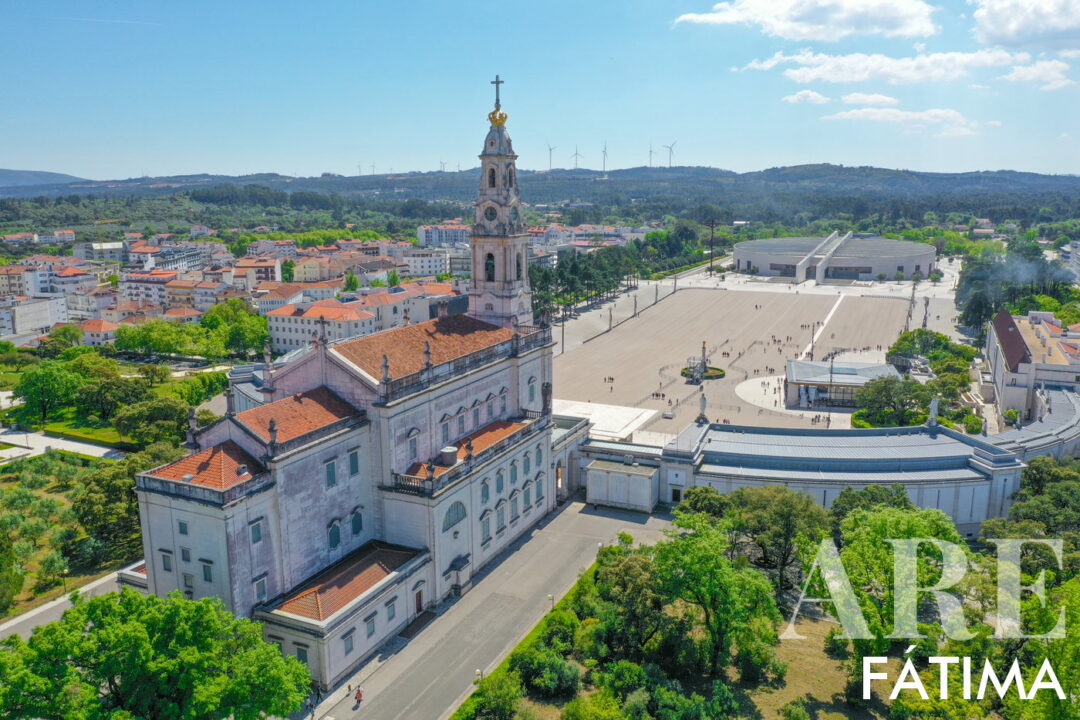
Fátima Sanctuary, with the Basilica of Nossa Senhora do Rosário de Fátima, the Chapel of the Apparitions and the Basilica of the Holy Trinity in the background
Fátima: located near Leiria, it is one of the most sought after religious centers in the world, where the three little shepherds witnessed the apparition of Nossa Senhora de Fátima on May 13, 1917. The busiest time of the The city is the time of pilgrimages, between May 13th and October. On this 13th of May the Candles Procession at night takes place, a unique event in the country. In Fátima, there is the Basilica of the Holy Trinity, the Valinhos Sanctuary and the Museum of the Life of Christ.
Lagoa da Ervedeira
Lagoa da Ervedeira: is located in Pinhal de Leiria, in the Mata do Urso zone and in the transition area between the regions of Beira Litoral and Alta Estremadura. This lagoon has about 2 km of beach and is the ideal place for sport fishing and water sports.
Monte Real
Monte Real: it is the old royal village of the Portuguese king D. Dinis and a spa. D. Dinis made this village his vacation and hunting residence, ordering the construction of the Royal Palace. In the village of Monte Real we highlight the Chapel of Rainha Santa, the Termas de Monte Real, the Chapel of São João Batista, a pillory of 1573 and the Fonte da Rainha Santa, which believe they have miraculous waters.
Nazaré
Nazaré: summer resort in the district of Leiria that has gained worldwide prominence with giant wave surfing. In this fishermen’s land there is the Sítio, the highest point in the village and its best viewpoint. This high point of the city is closely linked to the myth of its foundation and to the cult of Nossa Senhora da Nazaré: according to the legend, the mayor D. Fuas Roupinho, when chasing a deer, was falling on a precipice and will have been saved by Our Lady of Nazareth. As a form of retribution, D. Fuas Roupinho had Ermida da Memória built, a small chapel. In this place is the Sanctuary of Nossa Senhora da Nazaré built in the 18th century. Nazaré’s culture is deeply related to the sea, which is reflected in handicrafts, namely the dresses with seven skirts, fishing nets, canastas and traditional dolls. Gastronomy also reflects this proximity and intimate relationship with the sea through gastronomy, such as Caldeiradas de Peixe, Sopa de Peixe, Açorda de Marisco and Carapaus Secos. Nazaré is known for its parties, namely the parties of Nossa Senhora da Nazaré, the Carnival of Nazaré and the New Year, with a firework that is reflected in the Atlantic Ocean. A picture worthy of a postcard
Óbidos
Óbidos: is an authentic medieval village-museum located within the castle walls located in the district of Leiria. Óbidos has an inn that dates back to the Middle Ages, the Mother Church of Santa Maria, the Chapel of São Martinho, the Church of Senhor da Pedra, a completely walled citadel. Close to Óbidos are two excellent golf courses: the Guardian Bom Sucesso Golf and the Royal Óbidos Spa & Golf Resort. This medieval village is known for its parties that boost tourism and the city’s economy. Among them, the following are worth noting: the Holy Week Festivals, which recreate the steps of Jesus Christ on the Via Sacra, the Ancient Music Festival, the International Chocolate and Óbidos Festival at Christmas.
Peniche
Peniche: is a Portuguese fishing village located in the district of Leiria, it was an important military complex to protect against invasions from the Ocean. It is currently one of the best surf destinations in Europe, with dozens of surfcamps and a world-class surf environment. In this locality, the Fort of Peniche which was built by D. João IV in the 17th century is worth mentioning. During the dictatorship of António Oliveira Salazar it was transformed into a political prison, having recorded one of the most extraordinary escapes carried out by Portuguese political prisoners. Peniche is the largest bobbin lace center in the country, a century-old art that requires a lot of expertise. In Peniche we can visit Baleal beach, ideal for summer holidays, Supertubos beach, Consolação beach, ideal for surfing and bodyboarding and other beaches with conditions for surfing. The Cabo Carvoeiro, the hermitage of Nossa Senhora dos Remédios excavated in the underground rock, a lighthouse from 1796, the rock formation Nau dos Corvos and the Berlengas islands are worth mentioning here.
Pedrógão Beach
Praia do Pedrógão: the only beach in the municipality of Leiria, it is known for its extensive sand and dunes.
Tomar
Tomar: this town located in the district of Leiria is deeply linked to the Order of the Templars. In Tomar there are the Convento de Cristo, UNESCO World Heritage Site, the Mata dos Sete Montes, the church of Santa Maria do Olival, the Castelo Templário and the Synagogue of Tomar. In the vicinity of Tomar we find the Castle of Almourol and the reservoir of the Castelo do Bode Dam. Tomar is famous for the Festa dos Tabuleiros which takes place annually in July.
Vale do Lapedo
Vale do Lapedo: located in the parish of Santa Eufémia, about 13 kms from Leiria, it has unique fauna and flora in the country. In the valley is the Center for Interpretation of Abrigo do Lagar Velho
The gastronomy of Leiria
The gastronomy of Leiria has an increasing importance in the tourism of the region, having been elected Cultural Heritage of Portugal. The gastronomy of Leiria has the following typical dishes:
- Codfish with migas;
- Cod with black beans;
- Fish stew;
- Chanfana de Chaínça;
- Boa Vista Fashion Piglet;
- Megritos roasted on the grill;
- Marrazes Rice pudding;
- Brisas do Lis;
- Burnt chestnuts;
- Canudos from Leiria;
- Almond Jam;
- Pumpkin donut;
- Egg lampreys;
- Puffed Eggs;
- Milk liqueur;
- Wine from Cortes.
History of Leiria
Leiria has been populated since the Paleolithic Period (400,000 to 35,000 years old), having been found in this region “the Boy of Lapedo”, about 25,000 years old, is one of the most important prehistoric remains of Portugal.
Leiria was conquered from the Moors in 1135 by Dom Afonso Henriques, who ordered the castle to be erected, leading to an increase in the population of Leiria. It had a sustained political growth during the Middle Ages, received the donation of the first charter by Dom Afonso Henriques in 1142, the second charter in 1195, and in 1300 Dom Dinis donated the city of Leiria to Queen Santa Isabel.
Pinhal de Leiria, also known as Pinhal d’El-Rei or Mata Nacional de Leiria, is a pine forest with an area of 11000 hectares that stretches along the coast to Leira , had a great importance in the development of the region, having been planted initially by D. Afonso III with the objective of protecting the city, the castle and the agricultural lands of the erosion of the dunes caused by the winds of the ocean, had a very great importance during the time of maritime discoveries, as a source of raw material for the construction of vessels, causing the growth of the shipbuilding industry, glass industry, metallurgical industry and resin products. The city of Leiria was the first city in Portugal to have a typography, in 1466.
The city of Leiria rose to the episcopal city and seat of the district in 1545 during the reign of Dom João III.
The typical crafts of Leiria
Typical Leiria handicrafts consist of pottery, ceramics, porcelain (famous for the Caldas da Rainha tableware), earthenware, tapestry, embroidery, Alcobaça cheetah, loom blankets, stonework, tinwork, basketry and wooden miniatures linked to fishing.
Leiria has a thriving and constantly developing economy. This city has a job average above the national average. The Leiria region has about 50 thousand companies, linked to the most varied economic sectors. The industry plays an important role in the development of the region, namely the non-metallic mineral processing industry such as glass, ceramics, molds and plastics.
The capital of Lis invests in Research and Development, being the fifth destination in the country for this category of companies. This bet is supported by excellent higher education with emphasis on the Polytechnic Institute of Leiria, which is essential for boosting the economy. Leiria is the fourth chamber in the country with the best financial efficiency in 2015, which helps to create confidence in the performance of the region’s economy.
Personalities of Leiria
- António Varela (1902-1962): António Jorge Rodrigues Varela was born in Leiria. He studied architecture at the School of Fine Arts of Porto, having started his career in Leiria. The main works were the Casa da Moeda between 1933 and 1937 and the Canned Fish Factory in Matosinhos
- Francisco Rodrigues Lobo (1580-1621): was born in Leiria in a family of new Christians. Francisco Rodrigues Lobo is considered the father of the Baroque style in Portuguese Literature. He studied at the University of Coimbra and ended up drowning in the Tagus River when he made a trip between Lisbon and Santarém. The main works are The Pilgrim Shepherd of 1608, The Condestabre of 1609 and The Court in the Village of 1619
- Ernesto Korrodi (1870-1944): he was born in Zurich in 1870 and died in Leiria in 1944. He studied at the Escola de Arte Industrial until 1888, then from 1889 he attended the Escola Industrial de Braga for five years. He arrived in Leiria in 1894 to enter the Industrial School of Leiria. The main works are Reconstruction Studies on the Castle of Leiria, created by the League of Friends of the Castle in 1915, he founded a school of artistic stonework in Leiria. Currently the Municipality of Leiria organizes a tour in honor of Ernesto Korrodi that passes through some important places for the life and work of the architect, namely Villa Hortênsia, São Francisco Convent, Marques da Cruz Building, Sé de Leiria, Residencial Leiriense, Casa do Arco, Edificio Zuquete, Banco de Portugal, Beira Rio Pension, Church of Santo Agostinho, Sant’Ana Market, Town Hall and Leiria Castle
- José Lúcio da Silva (1902-1972): was born in Leiria and worked, most of his life as an employee of Banco Nacional Ultramarino de Leiria. Entrepreneur and benefactor, he created several associations and companies, namely the Rubber Industrial Society and the José Lúcio da Silva Theater
- Lino António (1898-1974): p Modernist-style painter who was born in Leiria and died in Lisbon. Lino António studied at Escola Domingos Sequeira in Leiria, Escola de Belas-Artes in Lisbon and at Escola de Belas-Artes in Porto. The main works are the frieze of the room of the President of the National Assembly in 1938, the frescoes of the triumphal arch and the balcony of the choir of the Church of Fátima in Lisbon in the year 1938, the stained glass windows of the Casa do Douro in Peso da Régua in 1945 or the frescoes in the lobby of the National Library of 1966 in Lisbon
- Narciso Costa (1890-1969): Narciso Casimiro Costa was born in Braga in Leiria. He was the son of one of the greatest goldsmiths in the country, Manuel Casimiro Costa and soon began to draw attention for his talent and excellent student that he was – he even received diplomas of recognition at the Bartolomeu dos Mártires Industrial School. Narciso Costa studied at the Commercial and Industrial School of Braga and École des Arts et Métiers in Geneva, Switzerland. He arrived in Leiria in 1914 to teach General Design classes at the Domingos Sequeira Industrial School in 1914. Narciso Costa distinguished himself as a chisel and designer, having distinguished himself in the creation of the Technical Atelier of Architecture and Decoration in the 1930s together with António Varela
Curiosities about Leiria
- Pinhal de Leiria was ordered to be planted by Dom Dinis so that the construction of the ships was possible
- The Courts of Leiria of 1254 became famous for being the first time that representatives of all social classes came together: Nobility, Clergy and the People
- The Courts of 1372 and 1376 were also held in Leiria
- The first paper mill in Portugal was built in Leiria in 1411
- Leiria Castle receives approximately 50 thousand visitors per year
- Eça de Queiroz was administrator of the municipality of Leiria
- Eça de Queiroz wrote the book O Crime do Padre Amaro in Leiria
- Dom Dinis dedicated some of the poems he wrote to the city of Leiria
- Leiria has been a city since the 16th century
The main events and festivities in the Municipality of Leiria are:
- Festivals of the City: are held on 22 May in honor of the passage to the city in 1545;
- Feasts of Nossa Senhora da Encarnação: are held in August in honor of this patron saint of the city of Lis;
- Feast of the Body of God: held in May;
- Annual Music Festival: held in July;
- Regional Festival of Gastronomy and Crafts: takes place in the first week of September;
- Leiria the city of Natal,
- Taste Leiria Sweets,
- Opera Heritage Leiria,
- Extramural Wall Gothic Festival,
- Leiria On Wheels,
- National Electric Vehicles Meeting (ENVE)
- Leiria Paredes with History.


